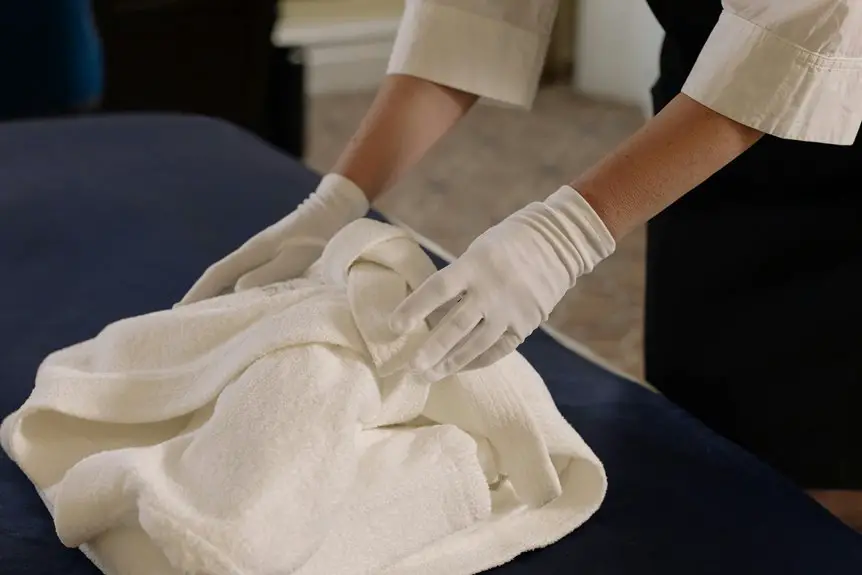Linen typically shrinks between 2% to 10% after the first wash. To manage shrinkage, wash your linen in cold water and use a gentle cycle. Avoid harsh detergents, and air dry whenever possible. If you must use a dryer, keep the heat low and remove linens while they’re slightly damp. Pre-washing items before their first use can also help reduce shrinkage. Stick around to uncover more tips on caring for your linen effectively!
Table of Contents
Key Takeaways
- Expect initial linen shrinkage between 2% to 10% after the first wash due to its natural fibers.
- Use cold water and gentle cycles to minimize shrinkage during washing.
- Air drying is recommended; avoid high heat settings in the dryer to prevent damage.
- Pre-wash linen items before first use to reduce future shrinkage risks.
- Regular maintenance, such as inspecting for wear and rotating items, extends linen lifespan and helps manage shrinkage.
Understanding Linen Shrinkage Rates
When you understand linen shrinkage rates, you can better manage your laundry processes and maintain the quality of your linens.
Linen typically shrinks between 2% to 10% after the first wash, depending on its weave and finishing. Knowing this helps you anticipate changes in size and adjust your washing techniques accordingly.
For instance, you might choose to wash linens in cold water or avoid high heat during drying to minimize shrinkage. Keeping an eye on these rates guarantees your linens fit properly and last longer.
Factors Influencing Shrinkage
When it comes to linen shrinkage, the fiber content and washing techniques you use play essential roles.
Different fibers react uniquely to washing and drying, leading to varying shrinkage rates.
Fiber Content Impact
Understanding the fiber content of linen is crucial since it directly influences shrinkage during washing and drying.
The composition of your linen fabric can affect how much it shrinks, so it’s important to know what you’re working with. Here are three key factors to take into account:
- Pure Linen vs. Blends: Pure linen tends to shrink more than blended fabrics, as the additional fibers can stabilize the structure.
- Thread Count: Higher thread counts may result in less shrinkage, as the tighter weave holds the fibers together better.
- Processing Techniques: Fabrics that undergo pre-shrinking or special treatments may exhibit reduced shrinkage, making them more stable through washes.
Washing Techniques Variability
While your washing techniques might seem straightforward, they can greatly influence linen shrinkage. The temperature of the water you use plays a key role; hot water can cause more shrinkage compared to cold.
Additionally, how you load your machine matters. Overloading can lead to uneven washing, increasing the risk of shrinkage. You should also consider the washing cycle you choose; a gentle cycle is often best for linen.
Don’t forget about the detergent; harsh chemicals can weaken fibers, making them more prone to shrinking. Finally, air-drying is usually kinder to linen than using a dryer, which can further exacerbate shrinkage.
Measuring and Calculating Shrinkage
When it comes to managing linen shrinkage, knowing how to measure and calculate it accurately is essential.
You’ll need to understand the shrinkage calculation method and the specific measurement directions to get reliable results.
Keep in mind that variability in shrinkage rates can affect your final outcome, so let’s break it down step by step.
Shrinkage Calculation Method
To effectively manage linen shrinkage, you’ll need a reliable method for measuring and calculating it. Here’s a straightforward approach to help you:
- Initial Measurement: Start by measuring the original dimensions of your linen before washing. Use a tape measure for accuracy.
- Post-Wash Measurement: After washing and drying, measure the linen again. Verify it’s completely dry to get an accurate size.
- Calculate Shrinkage Percentage: Use the formula:
[(text{Original size} – text{Post-wash size}) / text{Original size} times 100]
This will give you the shrinkage percentage.
Measurement Directions Explained
Accurate measurement is essential for effectively managing linen shrinkage, as it directly impacts your calculations. Start by measuring your linen before washing. Use a fabric tape measure for precision, noting both the length and width.
Once washed and dried, measure again using the same method. To calculate shrinkage, subtract the post-wash measurements from the pre-wash figures. Divide this difference by the original measurements, then multiply by 100 to get a percentage.
For example, if a sheet shrinks from 100 inches to 96 inches, the shrinkage is 4%. By consistently applying these steps, you’ll develop a clearer understanding of shrinkage patterns in your linens, which helps you make informed decisions about care and purchase.
Variability in Shrinkage Rates
Variability in shrinkage rates can greatly affect your linen management, as different fabrics and washing conditions can yield varying results.
To effectively measure and calculate shrinkage, consider these factors:
- Fabric Type: Different fibers, like cotton and linen, have unique shrinkage properties. Always check the specific fabric guidelines.
- Washing Conditions: Water temperature, detergent type, and wash cycle can markedly impact shrinkage. Hot water usually causes more shrinkage than cold.
- Drying Method: Air drying tends to reduce shrinkage compared to tumble drying, which can further tighten the fibers.
Effective Methods for Managing Linen Shrinkage
While managing linen shrinkage can seem challenging, implementing effective strategies can considerably reduce its impact.
Start by pre-washing linens in cold water to minimize shrinkage during future washes. Use a gentle cycle and avoid overloading your washing machine, which can lead to uneven cleaning and increased shrinkage.
When drying, opt for low heat settings and remove linens while they’re slightly damp to help maintain their shape. Additionally, consider using a fabric conditioner to soften fibers and reduce tension.
Regularly inspect your linens for wear and tear, as damaged items are more prone to shrinkage. By adopting these methods, you can effectively manage shrinkage and extend the life of your linens.
Tips for Preventing Excessive Shrinkage
To prevent excessive shrinkage, it’s essential to pay attention to how you wash and dry your linens. Here are some practical tips to help you maintain their size and shape:
Prevent excessive shrinkage by washing linens in cold water and air drying whenever possible for optimal care.
- Wash in Cold Water: Always use cold water for washing linen. Hot water can cause fibers to contract, leading to shrinkage.
- Gentle Cycle: Opt for a gentle cycle on your washing machine. This minimizes agitation, reducing the risk of fabric distortion.
- Air Dry: Whenever possible, air dry your linens instead of using a dryer. If you must use a dryer, choose a low-heat setting and remove them while slightly damp to prevent over-drying.
Comparing Linen Shrinkage With Other Fabrics
When it comes to shrinkage, linen behaves quite differently compared to other fabrics like cotton or polyester.
Linen typically shrinks about 4-10% after the first wash, while cotton can shrink up to 20% if not pre-shrunk. Polyester, on the other hand, usually resists shrinking altogether due to its synthetic fibers.
You’ll find that linen’s natural structure allows it to breathe, making it less prone to extreme shrinkage, but it still requires careful handling to maintain its shape.
Unlike cotton, which can stretch after washing, linen tends to retain its form better.
Understanding these differences can help you manage your expectations and care practices for each fabric, ensuring your items stay in great shape for years to come.
Practical Tips for Caring for Linen Items
Caring for your linen items can be straightforward if you follow a few essential tips.
Caring for your linen items is easy with a few simple tips for maintenance and longevity.
Linen is durable, but proper maintenance guarantees it stays looking fresh and lasts longer. Here’s what you should do:
- Wash with Care: Use a gentle cycle with cold water and mild detergent. Avoid bleach, as it can weaken the fibers.
- Air Dry: Whenever possible, hang your linen items to dry. If using a dryer, opt for a low-heat setting and remove them while slightly damp to minimize shrinkage.
- Iron When Damp: Ironing linen while it’s still slightly damp helps smooth out wrinkles more easily. Use a hot iron and steam for the best results.
Frequently Asked Questions
Can I Reverse Shrinkage in Linen After Washing?
You can’t completely reverse shrinkage in linen, but you can try soaking it in lukewarm water with fabric conditioner. Gently stretch the fabric while it’s damp, and let it air dry to restore some size.
How Does Linen Shrinkage Affect Garment Fit?
Did you know linen can shrink up to 10% after the first wash? This shrinkage affects garment fit, often tightening the fabric and altering the overall silhouette, which may require adjustments for a comfortable wear.
Are There Specific Brands Known for Low Shrinkage Linen?
Yes, some brands like Eileen Fisher and J.Crew are known for producing low shrinkage linen. When you choose these brands, you’re likely to enjoy better fit and durability, minimizing any unpleasant surprises after washing.
What Is the Best Way to Store Linen to Prevent Shrinkage?
To prevent shrinkage, you should store your linen in a cool, dry place. Avoid direct sunlight and damp environments. Use breathable storage bags or containers to keep moisture and pests away from your fabric.
Does Repeated Washing Increase Shrinkage Over Time?
Washing linen’s like a dance; the more you twirl, the more it can change. Yes, repeated washing can increase shrinkage over time, so wash gently and follow care instructions to keep your linens in shape.
- Does Chiffon Fabric Stink - July 15, 2025
- Does Chiffon Fabric Affect the Economy - July 15, 2025
- Does Cotton Fabric Have a Nap - July 15, 2025






